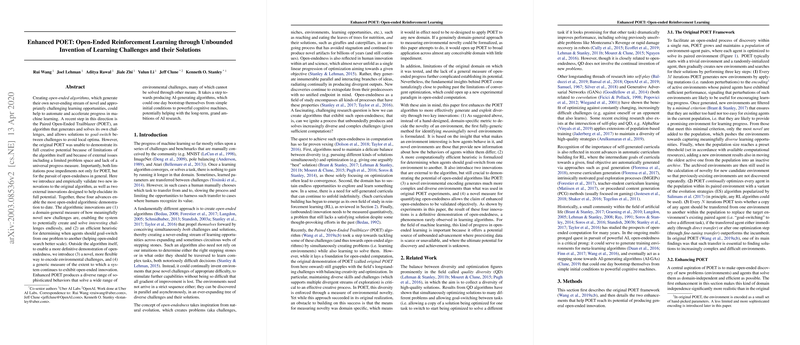An Analysis of Enhanced POET: Advancements in Open-Ended Reinforcement Learning
The paper "Enhanced POET: Open-Ended Reinforcement Learning through Unbounded Invention of Learning Challenges and Their Solutions" seeks to address the limitations and propose enhancements to the Paired Open-Ended Trailblazer (POET) framework. POET represents a critical step in the quest for machines that autonomously generate increasingly complex tasks and develop corresponding solutions, a concept inspired by natural evolution and human innovation. This discussion provides a rigorous examination of the proposed enhancements, their empirical validation, and implications for future AI developments.
Core Innovations
The enhancements to POET introduced in this paper extend from two primary fronts: algorithmic and infrastructural.
- Algorithmic Enhancements:
- Domain-General Novelty Metric: The introduction of Performance of All Transferred Agents Environment Characterization (PATA-EC) is pivotal. PATA-EC offers a radical shift to a domain-independent method of measuring novelty based on agent behavior. This generality allows POET to transcend specific problem domains, thereby facilitating broader application.
- Efficient Transfer Mechanism: By adjusting how solutions transfer between challenges—namely through a more stringent threshold and improved computational efficiency—POET mitigates previous inefficiencies, reducing false positives and computational overhead.
- External Enhancements:
- Expressive Environment Encoding: The shift from static, hand-crafted encodings to Compositional Pattern Producing Networks (CPPNs) exponentially broadens the potential environment space, encouraging the emergence of complex and unexpected task landscapes.
- Quantitative Measure of Open-Endedness: Accumulated Number of Novel Environments Created and Solved (ANNECS) provides a rigorous metric for assessing continuous innovation within the system, ensuring that the process remains dynamic.
Empirical Validation
The enhanced POET has showcased its capability of sustaining open-endedness through experiments with environments encoded via CPPNs. These environments yielded higher complexity and diversity compared to prior realizations, as evidenced by the varying obstacle landscapes synthesized during model runs. Notably, the comparative longevity of POET’s innovation, affirmed by an increasing ANNECS metric, suggests that these enhancements effectively prolong the open-ended exploration of new problem-solution pairs.
Notably, the rigorous empirical evaluation highlights that traditional reinforcement learning algorithms (like Evolutionary Strategies (ES) and Proximal Policy Optimization (PPO)) struggle to solve advanced environments hashed out in later stages by POET without its implicit curriculum. This finding underscores POET’s distinctive ability to organically generate the stepping-stones needed for such complex challenges, which are often overlooked by single-path curriculum approaches.
Implications and Future Directions
Enhanced POET marks substantial progress in the domain of open-ended AI systems, positioning it as a potentially unbounded algorithmic model. The domain-general nature of PATA-EC and the expressiveness of CPPNs signify freedom from predefined confines, fostering broadened exploration and innovation prospects across diverse domains. This approach could profoundly impact areas reliant on creativity and novelty, such as autonomous robotics and AI-driven discovery, where pre-existing datasets are sparse or task requirements evolve unpredictably.
Looking forward, the paper intimates that further augmentation to the domain scope of POET could exponentially expand its innovative lifespan. Harnessing environments that approach limitless complexity may allow POET to emulate natural evolutionary histories more closely, sustaining an indefinite open-ended learning trajectory. Furthermore, integrating more computational resources or refining the CPPN representations might unlock more intricate environment architectures beyond current computational limitations.
In conclusion, Enhanced POET bears testament to the evolving landscape of AI research, in which the pursuit of open-ended, autonomous problem-solving capabilities could pave the way for creating fundamentally new kinds of intelligent machines. As these systems mature, they can provide profound insights into both the architecture of intelligence and the nuances of problem-solving pathways in dynamically changing landscapes.
